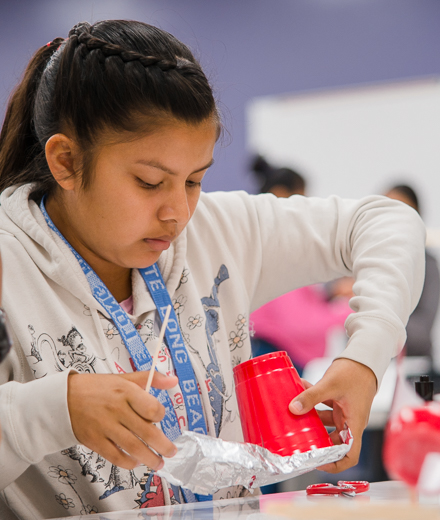STEM @ The Beach camp gives students hands-on approach to engineering

The robots wheeled around a white box, picking up red, green, and blue cubes. Others robots pushed the cubes around as the young students were unable to remotely command the robots to do as they wished, while another robot had trouble keeping its pieces intact.
The learning curve at last week’s STEM @ The Beach camp, led by College of Education assistant professor Cathrine Maiorca, had its ups and downs. Yet, for the 17 middle school students in the week-long session at Cal State Long Beach, it was an overwhelming success. Not only did the seventh and eighth graders build a working robot, they made rockets out of plastic bottles, watched videos, listened to leading engineers and participated in various other activities.
The inaugural camp partnered with Long Beach Unified School District to give young students a taste of engineering and perhaps plant the seeds of a career in the multi-faceted field.
Maiorca devised the idea of holding a STEM camp on campus after attending a conference last year, when she met professors from the University of Kentucky and Iowa State University who hold similar camps. She said they helped mentor and develop the camp, designed to engage low-income and under-represented middle school students in STEM activities and introduce them to STEM professions.
“This is important because it is in middle school where students begin life decisions such as staying in school,” Maiorca said. “Students also begin to choose what classes they want to take in high school, which will impact their college and career readiness.”
The camp also allowed preservice teachers the opportunity to practice working with children in a problem based, integrated STEM environment.
“This is a valuable tool for mathematics teachers because it promotes productive struggle in the mathematics classroom as well as mathematical discussions, which is where our K-12 students gain the most learning,” Maiorca said.
Maiorca said the kids seemed to enjoy the camp and many asked to be invited again next summer.
“The robot was kind of easy for me,” said Greg Ahumada, an incoming eighth grader. “I like science and math.” His robot managed to easily pick up the cubes and drop them over the edge of the box.
Ahumada said going to the camp sparked his interest in engineering, and he could see himself studying it further in high school, maybe college.
Sandy Barrera’s robot struggled from the start. First, she and her partner lost a piece. Once they found it, they made a mistake and had to start over. Barrera said despite the trouble, she enjoyed the part when they got to eat the candy the robot managed to pick up with their “hands.”
Earlier in the week, the kids gathered marbles, grabbed Popsicle sticks and red plastic cups and began to build a top-down water flow inspired by rice terraces found in the Philippines. The irrigation system was an idea inspired by Fluor, a global engineering and construction company, which sent representatives to CSULB to lead the class.
“For Fluor, education is one of our highest priorities, the No. 1 priority as far as outreach and giving back to the community,” said DeeDee Rosenthal, community relations manager for Fluor. “We’ve had a previous relationship with the College of Education … so, when they approached us with this it was a natural fit for us.
“(The purpose is) being able to help underserved students in the Long Beach community and expose them to a camp like this and professionals in the industry – letting them meet engineers, talk to them face-to-face, and learn what Fluor does.”






